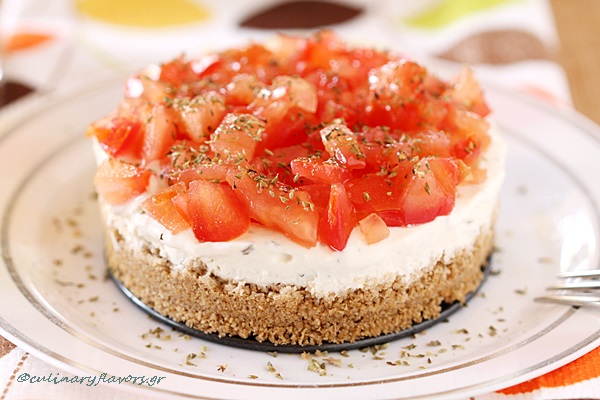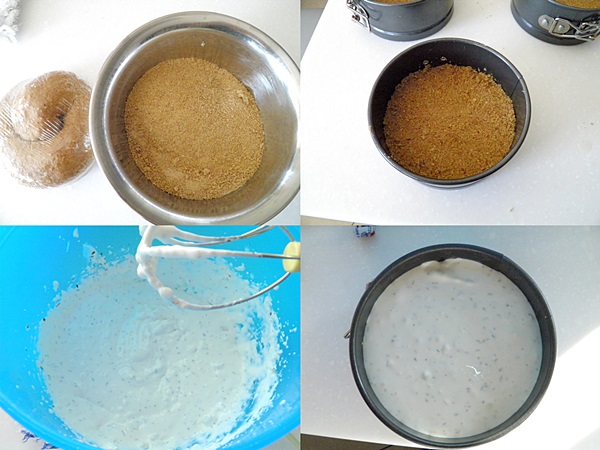Η συνταγή και στα ελληνικά στο τέλος της ανάρτησης.
According to Hesiod’s Theogony, at the beginning of the world there were two gods ruling, Uranus (the Sky) and Gaia (the Earth). Uranus, afraid of losing his dominance to his descendants, cast his children into the depths of the earth. Gaia, not liking her husband’s attitude, hid her son Cronus in their bed and later she helped him dethrone Cronus. According to myth, Gaia advised Cronus to castrate Uranus and throw his genitals into the sea. Thus, the goddess of beauty and love Aphrodite was born. You can check her birth and story in Pan Seared Scallops with Apple Cider Cream post.
Nevertheless, story seems to repeat itself and Cronus was to share his father’s fate. Afraid of his father’s prophetic curse, he was swallowing every child who was born, so no one could take his place. Cronus’ wife Rhea gave birth to five children before Zeus, who all ended up in their father’s stomach. When Rhea realized she was pregnant with Zeus, she thought that that child should not share the same fate as the previous ones, so she asked for the help of her parents, Uranus and Gaia. Following their advice, she went to Crete and gave birth to Zeus hidden in a cave in the Cretan mountains. As soon as Rhea gave birth to Zeus, the future father of gods, she gave him to the Curetes, a legendary tribe, to look after him. They danced and stamped, beat their drums and clashed their shields to cover the baby’s crying.

In order to dispel any fears of her husband Cronus, Rhea gave him a stone wrapped in swaddling clothes instead of the baby. He swallowed it at once feeling secured that his throne was at no risk as there were no descendants left.
In the meantime, little Zeus was growing up in Crete hidden from his father. Amalthea, a goat or according to others a nymph, suckled the holy infant from her horn and the nymph Melissa nursed Zeus and looked after him, giving him the nourishing honey so he would grow more quickly. When Zeus grew up and came of age, he followed his father’s and grandfather’s steps, overthrew Cronus, took his throne and became the first among the first in mount Olympus. (Source: explorecrete.com)

Crete is the largest island of Greece and the fifth largest in Mediterranean Sea. Cretan diet has become famous for its healthy ingredients, the usage of greens and fibers. Cretan Dakos is one of the most complete meals I know and it is perfect either as a salad or as a meal itself. I have decided to change things up a little bit and make a savory cheesecake that will have the taste and ingredients of the Cretan Dakos. This is such a tasty, elegant appetizer and you can even serve it as first course. I, also, since we are in summer season, decided to make it using light ingredients so as to be as skinny as possible. So, feel no guilt and enjoy this delicious savory cheesecake!
- 60 gr. / 2 oz. barley rusk, finely crumbled the same way you do with digestives
- 2 to 3 tbsp margarine or butter
- 200 gr. / 7 oz. light cream cheese
- 70 to 100 gr. / 2.5 to 3.5 oz. feta light 12%, crumbled
- ½ tsp dried oregano
- ¼ tsp dried basil
- 1 large tomato chopped per two cheesecakes
- ½ tsp dried oregano per cheesecake
- Salt, pepper
- Olive oil to drizzle on top
- Melt the butter or margarine.
- In a bowl mix the margarine with the barley crumbles.
- Divide the mixture to the two small molds and press it towards the bottom of the mold with your fingertips.
- In another bowl mix the cream cheese, the feta crumbles, the oregano and the basil.
- Divide the batter to the two cheesecake molds and level it.
- Put in the fridge for couple of hours to stabilize.
- A few minutes before serving them, take them out of the fridge.
- Unmold them and add on top of them the tomato.
- Add salt, pepper, the oregano and drizzle with olive oil.
- Serve as individual salad or first course.
- If you cannot find barley rusk, use whatever is handy for you, it would be better if it is whole grain.
- Start by adding 70 gr. / 2.5 oz. of feta try it and if you want it more salty add some more. It is completely up to you.
- If you want it to be really skinny, use margarine instead of butter and drizzle couple of tsp of olive oil per cheesecake.
- 60 γρ. κριθαρένιο παξιμάδι, τριμμένο
- 2 με 3 κ.σ. μαργαρίνη ή βούτυρο
- 200 γρ. Light τυρί κρέμα
- 70 έως 100 gr. φέτα 12%, τριμμένη
- ½ κ.γ. ρίγανη
- ¼ κ.γ. ξηρό βασιλικό
- 1 μεγάλη ντομάτα, ψιλοκομμένη ανά δύο cheesecakes
- ½ κ.γ. ρίγανη ανά cheesecake
- Αλάτι, πιπέρι
- Ελαιόλαδο για να ρίξετε από πάνω
- Λιώστε το βούτυρο ή τη μαργαρίνη.
- Σε ένα μπολ ανακατέψτε τη μαργαρίνη με το τρίμμα κριθαροκουλούρας.
- Μοιράστε το μείγμα στα δύο μικρά καλούπια και πιέστε το προς το κάτω μέρος του καλουπιού με τα δάχτυλά σας.
- Σε ένα άλλο μπολ ανακατέψτε το τυρί κρέμα, τη φέτα, τη ρίγανη και το βασιλικό.
- Μοιράστε το μίγμα στα δύο cheesecake πάνω από το στρώμα κριθαροκουλούρας.
- Βάλτε στο ψυγείο για μερικές ώρες να σταθεροποιηθεί.
- Λίγα λεπτά πριν από το σερβίρισμα τους, βγάλτε τα από το ψυγείο.
- Ξεφορμάρετε και προσθέστε στην κορυφή τους η ντομάτα.
- Προσθέστε αλάτι, πιπέρι, ρίγανη και ρίξτε ελαιόλαδο.
- Σερβίρετε ως ατομική σαλάτα ή πρώτο πιάτο.
- Δοκιμάστε προσθέτοντας 70 γρ. φέτα και αν το θέλετε πιο αλμυρό, προσθέστε λίγο περισσότερο.
- Αν θέλετε να είναι πραγματικά light χρησιμοποιείστε μαργαρίνη αντί για βούτυρο και ρίξτε 2 κ.γ. ελαιόλαδο ανά cheesecake.


